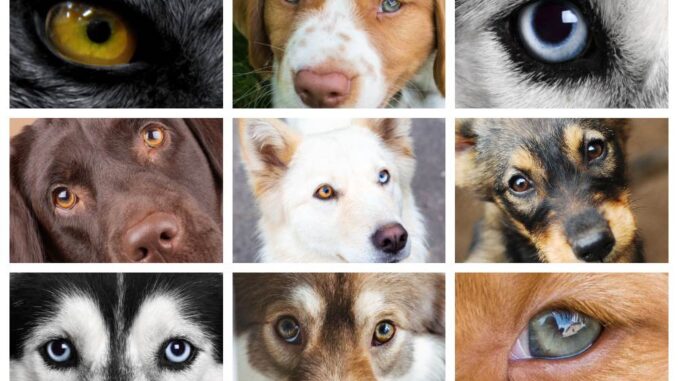
This article was updated on March 14th, 2024

Dog eye color can be an interesting spectrum, ranging from brown to blue, yellow to green, and even having multiple colors. In this article, our veterinary ophthalmologist, Dr. Tamir Spiegel, expands on the various eye shades in dogs with pictures of eyes by color (with a color chart).
Dog Eye Color Chart
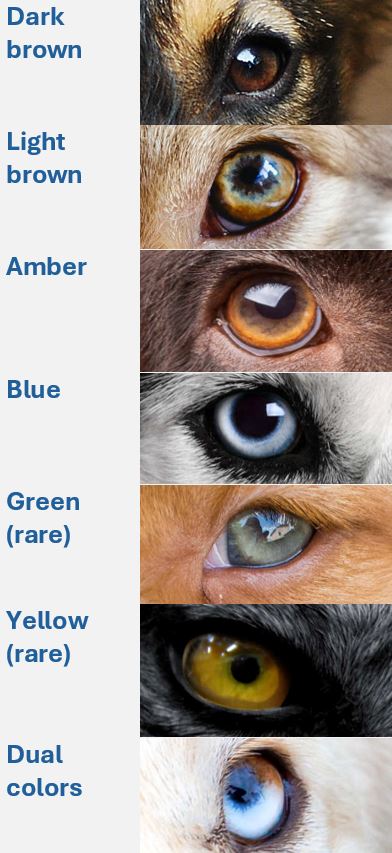
7 Most Common Eye Colors in Dogs (With Pictures)
1. Dark brown eyes
Brown is the most common eye color in dogs: it is found in many popular breeds, including Labrador Retrievers, German Shepherds, and Golden Retrievers – three of the top four most popular breeds in the US in 2022, according to AKC. Below is a picture of a Labrador with dark brown eyes:
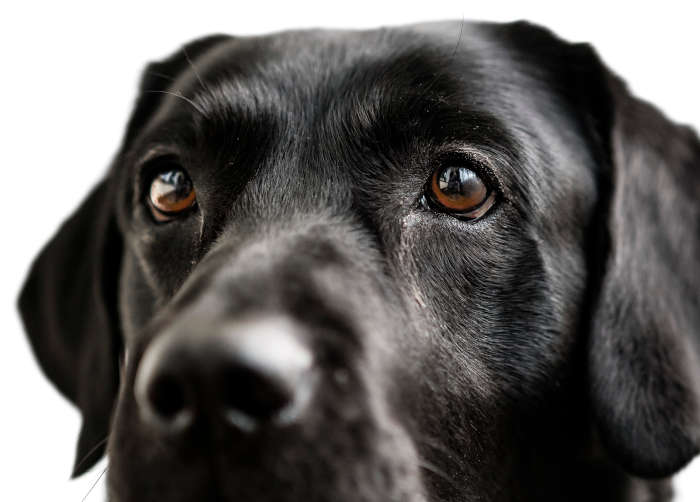
The dark brown color in a dog’s eyes is in part due to the presence of a pigment called melanin, which is produced by cells in the iris called melanocytes.
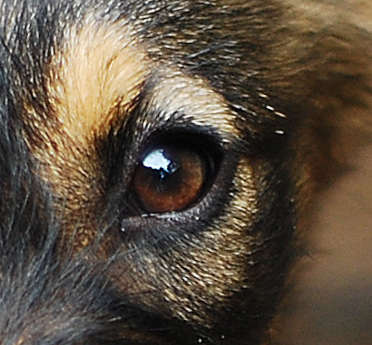
There are many different shades of brown. For example, some dogs may have very dark brown eyes that appear almost black, while others may have lighter brown eyes that are closer to amber or caramel in color.
The most popular dog breeds with mostly brown eyes include:
- Labrador Retriever (AKC – 2nd most popular breed)
- Golden Retriever (AKC – 3rd)
- German Shepherd (AKC – 4th)
- Boxer
- Beagle
- Bulldog
- Dachshund
- Poodle
It’s important to remember, however, that while certain breeds may have a higher incidence of brown eyes, eye color can vary even within a breed.
2. Light brown eyes
There are many different types of brown eyes in dogs. Light brown is a very common eye color in dogs. Pictured below is a dog with light brown eyes:
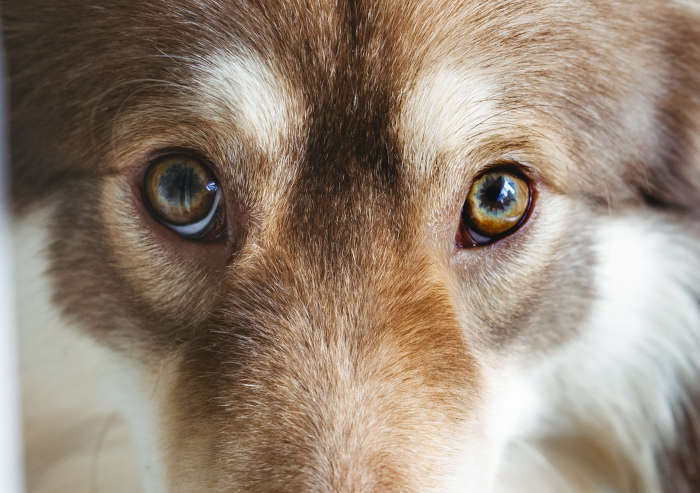
Some dog breeds, such as Cocker Spaniel, and Dachshund, are more likely to have light brown eyes, but eye color can vary even within a breed.
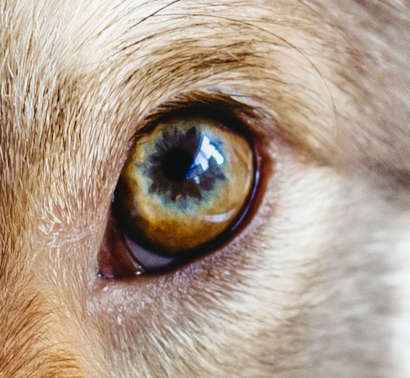
3. Amber eyes
Amber is a warm, rich color that is typically described as a yellowish-orange or reddish-brown. It can be a complex mix of different hues, ranging from golden yellow to deep brown, with a hint of red or orange.
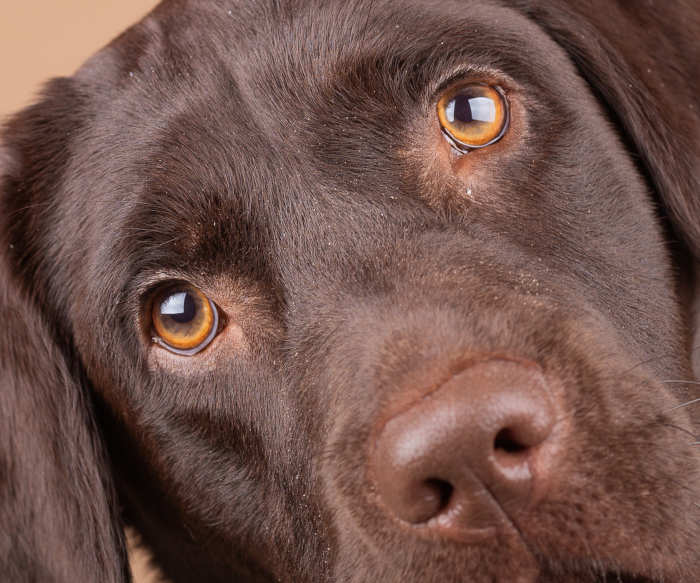
Some people describe the color as honey-like or resembling the shade of aged whiskey.
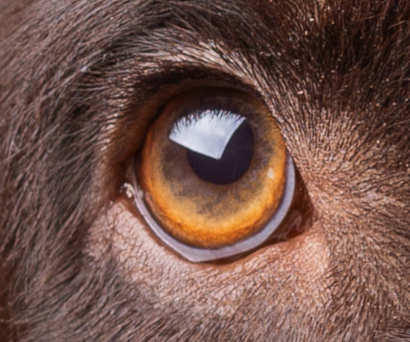
The following breeds are among those most likely to have amber eyes:
- Vizsla (AKC – 33rd most popular breed): The Vizsla is likely to have amber eyes, which complement its golden rust-colored coat.

- Rhodesian Ridgeback (AKC – 41st most popular breed): The Rhodesian Ridgeback breed is known for having a distinctive ridge of hair along its back, and many also have amber eyes.
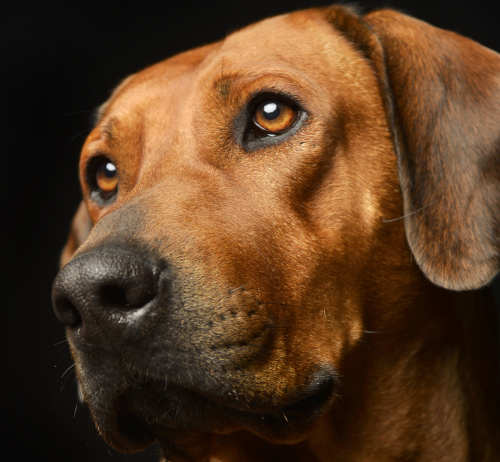
4. Blue eyes
Some dogs have blue eyes due to a lack of melanin in the iris of their eyes. Melanin is a pigment that gives color to the skin, hair, and eyes of dogs and other animals.
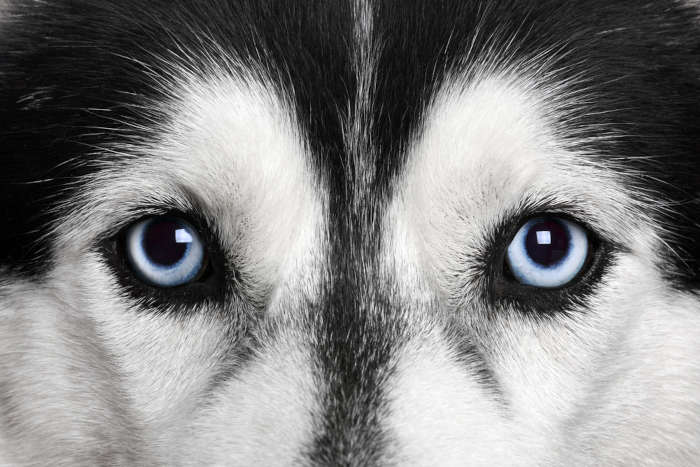
Phaeomelanin is the second pigment that determines canine coat color. This pigment is red with a default color of gold or yellow. Phaeomelanin creates reds that range from deep red (Irish Setter) to orange, cream, gold, yellow, or tan. Genes control the intensity of phaeomelanin, making the color stronger or weaker. This pigment is produced only in the coat and affects only hair color, while eumelanin affects eye and nose color (Genetics Basics: Coat Color Genetics in Dogs).
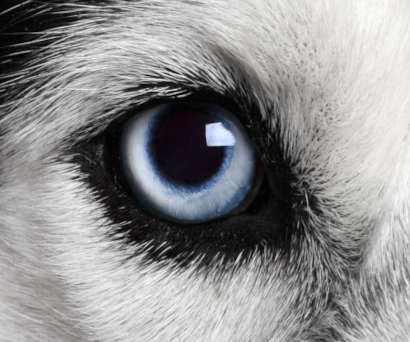
If eumelanin is absent in the eyes, the dog has blue eyes. Rarely, the entire coat is affected, resulting in an albino dog with red eyes. Researchers found that a genetic change, or mutation, on canine chromosome 18 is strongly associated with blue eyes in Siberian huskies.
Breeds that can have blue eyes include:
- Husky
- Australian Shepherd
- Border Collie
- Weimaraner
5. Green eyes (rare)
Green eyes in dogs are a rare and beautiful eye color. While green eyes are not common among all breeds of dogs, there are some breeds that have a higher chance of having this eye color.
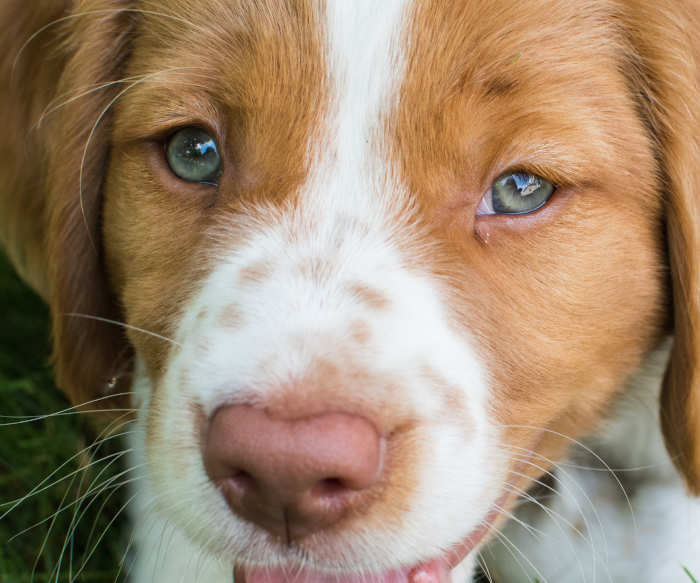
Green eyes can occur in a variety of dog breeds but are most commonly found in breeds such as:
- Pit Bulls
- Border Collies
- Australian Shepherds
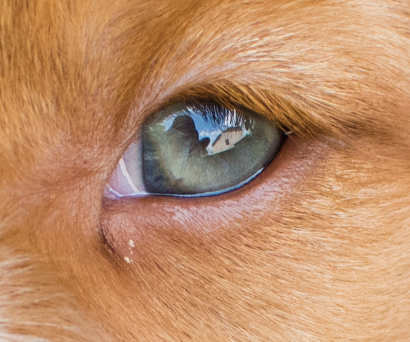
6. Yellow eyes (rare)
Some dogs have the unique trait of having yellow eyes instead of the more common eye color. This feature makes them stand out among other dog breeds, such as the Labrador Retriever, Cane Corso, and American Bulldog.
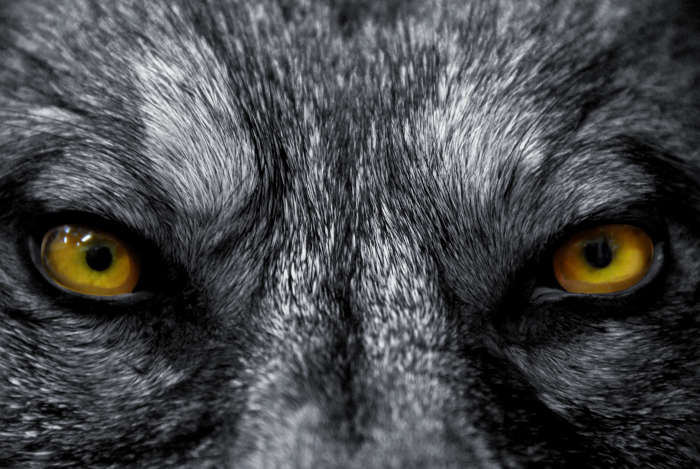
Some wolves also have yellow eyes, while others have brown, amber, or even blue eyes. This is because the amount of melanin in their eyes is lower, which allows the yellow color to be more visible.
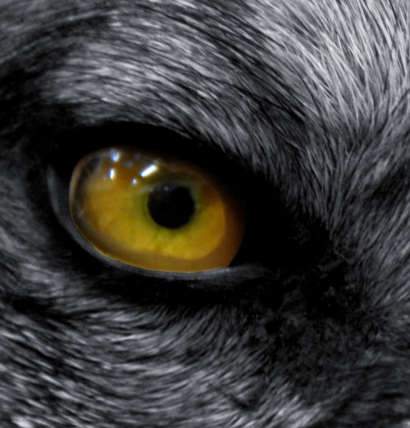
7. Dual colors (heterochromia)
This is due to a genetic condition (called heterochromia) in which a dog’s irises are different colors.
Heterochromia refers to variations in iris coloration. Both eyes, one eye only, or only part of an iris may be affected, and often there are concurrent variations in coat color. (Slatter’s Fundamentals of Veterinary Ophthalmology ; David J. Maggs, Paul E. Miller, Ron Ofri ; Elsevier ; Uvea ; P 228)
1. Heterochromia iridis refers to variations in pigmentation of different regions of the iris in the same eye. (Slatter’s Fundamentals of Veterinary Ophthalmology ; David J. Maggs, Paul E. Miller, Ron Ofri ; Elsevier ;Uvea ; P 228)
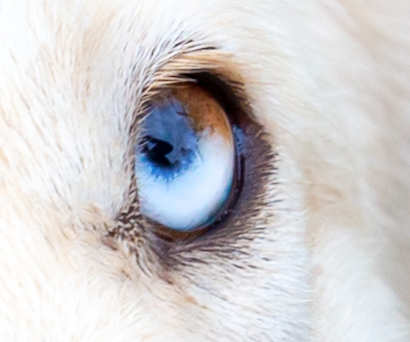
2. Heterochromia iridium refers to variations in coloration between the two eyes of the same animal. (Slatter’s Fundamentals of Veterinary Ophthalmology ; David J. Maggs, Paul E. Miller, Ron Ofri ; Elsevier ;Uvea ; P 228)
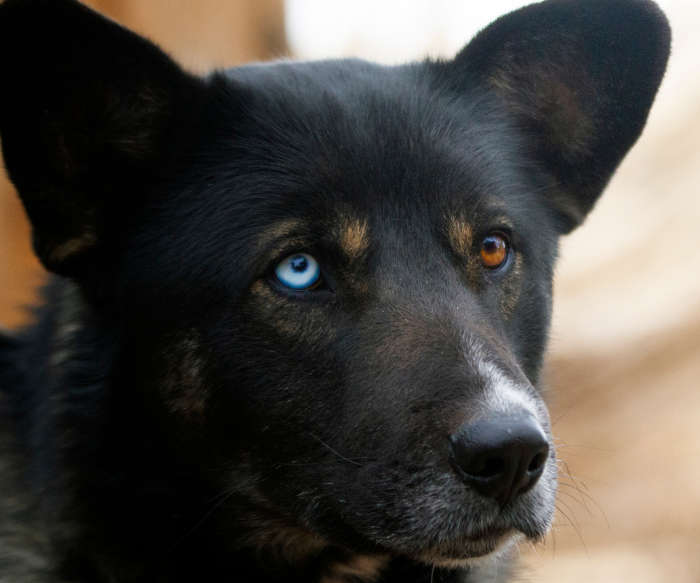
These color variations have been proposed to be due to localized reductions in the enzyme (tyrosine hydrolase) necessary for the production of melanin. (Slatter’s Fundamentals of Veterinary Ophthalmology ; David J. Maggs, Paul E. Miller, Ron Ofri ; Elsevier ;Uvea ; P 228)
Although heterochromia may be normal, blue iridal tissue has also been associated with eye abnormalities as well as with absence of or a small tapetum and lack of pigmentation of the nontapetal retina. (Slatter’s Fundamentals of Veterinary Ophthalmology ; David J. Maggs, Paul E. Miller, Ron Ofri ; Elsevier ;Uvea ; P 228)
An association between congenital deafness and heterochromia has also been recognized in the Dalmatian, Australian cattle dog, English setter, Australian shepherd, Boston terrier, Old English sheepdog, and English bulldog. (Slatter’s Fundamentals of Veterinary Ophthalmology ; David J. Maggs, Paul E. Miller, Ron Ofri ; Elsevier ;Uvea ; P 228)
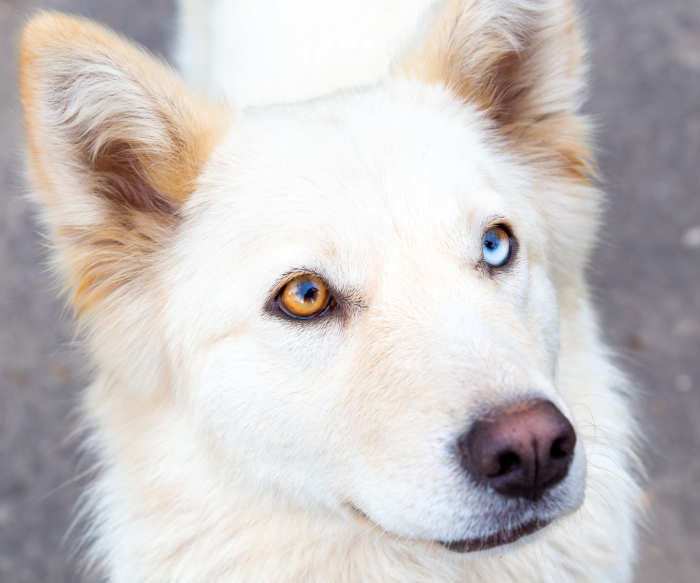
Lay terms for heterochromia are as follows:
• Wall eye: blue and white iris or part of an iris
• China eye: blue iris or part of an iris
• Watch eye: blue and yellow-brown iris or part of an iris
In most species, heterochromia is of no clinical significance (Slatter’s Fundamentals of Veterinary Ophthalmology ; David J. Maggs, Paul E. Miller, Ron Ofri ; Elsevier ;Uvea ; P 228)
The term “heterochromia” comes from the Greek words “hetero” (meaning “different”), and “chromia” (meaning “color”). For dogs with heterochromia, one iris may be blue or brown, while the other iris may be green, gray, or a different shade of blue or brown. Heterochromia can occur in one eye, as seen in the picture below:
Fun facts about dog eyes
1. The color of a dog’s eyes can change as they age. Puppies are often born with blue eyes, which can change to brown or another color as they grow older.
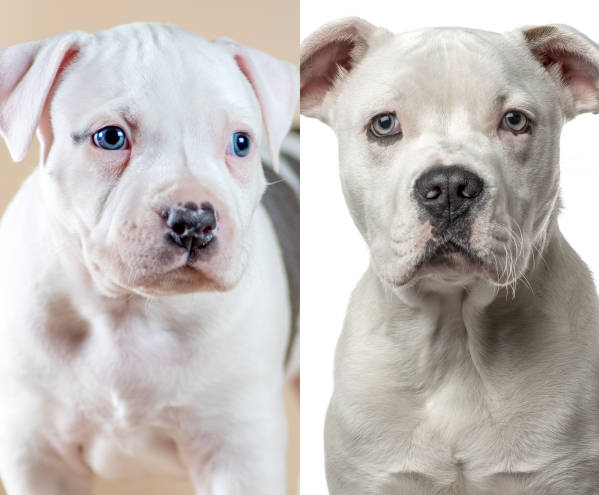
2. Dogs have a wider visual view than humans: dogs have a larger field of vision than humans. They have a visual field of about 250 degrees, while humans have a visual field of about 190 degrees.
3. Dogs can see better than humans in the dark: dogs have a higher number of rods in their eyes than humans do. This means they can see better in low-light conditions, making them well-suited to see in the dark.
4. Different breeds of dogs can have different eye shapes, although all dog breeds have round eyeballs, the structure and placement of eyes vary depending on the breed such as almond-shaped eyes in breeds like Huskies, and round eyes in breeds like Pugs.
5. Dogs can see less colors than humans. Dogs can see some colors, but not as many as humans can. Specifically, dogs can see shades of blue and yellow, but they have difficulty distinguishing between red and green. The color vision of dogs is similar to that of people with red-green color blindness. They see the world in shades of blue and yellow, and they may have difficulty distinguishing between red, green, and gray.
If you liked this post, you will like:
- Big & White Dog Breeds That Will Amaze You
What determines eye color in dogs?
Color depends on the amount of pigmentation (melanocyte) of the iridal stroma. The variation of color primarily results* from the:
- amount of pigmentation present,
- type of pigmentation,
- thickness of the anterior layer and
- degree of vascularization
In many instances, the coloration of the irides of domestic animals tends to be dark, varying from dark brown to golden brown, blue, and blue-green color. (Veterinary Ophthalmology; Basic Vision Sciences; Fourth Edition; Volume 1; Kirk N Gellat; p 66. Small Animal Ophthalmology; Uvea; Sally M. Turner; p 201)
Other references:
Veterinary Ophthalmology; Basic Vision Sciences; Fourth Edition; Volume 1; Kirk N Gellat; p 66. Small Animal Ophthalmology; Uvea; Sally M. Turner; p 201).
Disclaimer: This website's content is not a substitute for veterinary care. Always consult with your veterinarian for healthcare decisions. Read More.



Be the first to comment